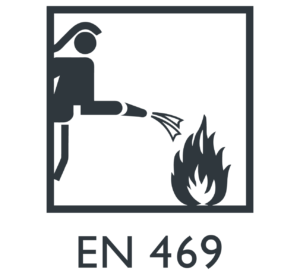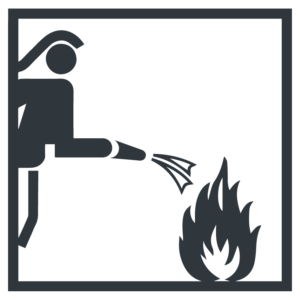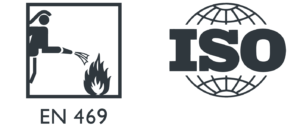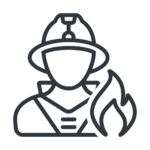Performance requirements for protective clothing for firefighting
EN ISO 469 – This European standard specifies the minimum required levels for protective clothing that is used during firefighting procedures and associated activities.
EN ISO 469 CERTIFICATION REQUIREMENTS
TEST METHOD
DESCRIPTION
MINIMUM COMPLIANCE VALUES
ISO 7000-2418
Protective equipment for firefighters – Pictogram.

ISO 13688

ISO 15025
Protective clothing – Protection against flames – Method of test for limited flame spread.
A1 o A2
ISO9151
Protective clothing for heat and flames: the assembly of components or of multilayer clothing must obtain the following performance levels and be classified as such. When performance levels 1 and 2 are present in the same garment or multilayer clothing assembly, it should be classified under the lowest level, that is, level 1.
| Index | Level 1 | Level 2 |
| HTL24 | ≥ 9.0 | ≥ 13.0 |
| HTL24 – HTL12 | ≥ 3.0 | ≥ 4.0 |
EN6942
Protective clothing – Protection against heat and fire: the assembly of components or of multi-layer clothing must obtain the following performance levels and be classified as such. When performance levels 1 and 2 are present in the same garment or multilayer clothing assembly, it should be classified under the lowest level, that is, level 1. The test is performed with a heat flow of 40 kW/m².
| Index | Level 1 | Level 2 |
| HTL24 | ≥ 10.0 | ≥ 18.0 |
| HTL24 – HTL12 | ≥ 3.0 | ≥ 4.0 |
ISO 13934-1
Three test samples must be tested in the warp direction and 3 test samples in the weft direction of the exterior material after application of radiant heat at a flow density of 10 kW/m².
Each test sample must have traction resistance of ≥ 450 N
ISO 17493
Resistance to heat at 180ºC (ISO 17493): over a 5-minute exposure time, each material utilised in the assembly of the clothing must not combust or melt, and must not shrink more than 5% in any direction. Each material is tested separately. Rigid accessories, of the kind or kinds that will be used in the finished garment, must function after performing this test.
–
ISO 13937-2
Textiles – Traction properties of fabrics – Part 2: Determination of maximum force using the tear method
≥ 25 N (exterior material)
ISO 13934-1
Textiles – Tensile properties of fabrics – Part 1: Determination of maximum force and elongation of maximum force using the strip method.
≥ 450 N (exterior material)
ISO 5077
Dimensional stability (EN ISO 5077) Each layer is tested separately. A sample is prepared with a combination of all of the materials that comprise the garment and sewn on all four sides. If the result is greater than 10%, 2 more samples are tested and the result is the mean of the 3 tests.
± 3% for woven fabrics and ± 5% for knitted fabrics.
EN6530
| Chemical product |
Concentration (%) |
Temperature ± 2ºC |
| NaOH | 40 | 20 |
| HCI | 36 | 20 |
| H2SO2 | 30 | 20 |
| C8 – H10 (o-xylene) | 100 | 20 |
There must not be any penetration up to the innermost layer of the garment, and the repellancy index must be classified at ≥ 80.
EN20811
Resistance to water penetration (EN 20811): every test, including the stitching, must achieve one of the two performance levels using a pressure increment of (0.98 ± 0.05) kPa/min;
• Level 1 < 20 kPa, for garments without a moisture barrier.
• Level 2 ≥ 20 kPa, for garments with a moisture barrier.
Markings will be Y1 or Y2, depending on the level achieved.
• Level 1 < 20 kPa, for garments without a moisture barrier.
• Level 2 ≥ 20 kPa, for garments with a moisture barrier.
Markings will be Y1 or Y2, depending on the level achieved.
EN31092
Minimum requirements are:
• Level 1 > 30 m²Pa/W
• Level 2 ≤ 30 m²Pa/W.
Markings will be Z1 or Z2, depending on the level achieved.
ISO 13506
ISO 13506 Manikin test is tested with a flow density of 84 kW/m² and an exposure time of 8 seconds.
EN24920
Performing the test at a temperature of 20ºC.
The exterior fabric must present a wetting level of ≥ 4.



